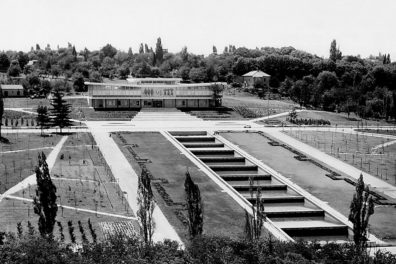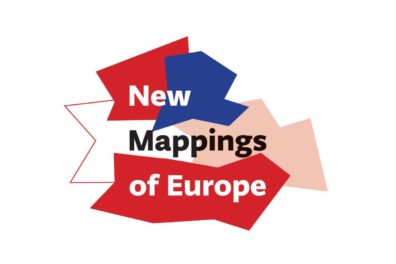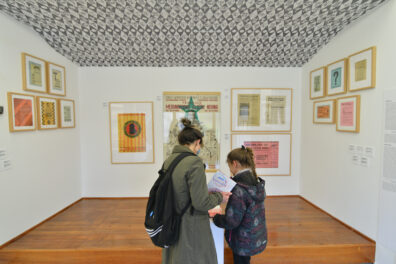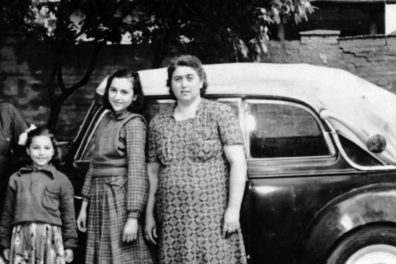
The Museum of Yugoslavia – Innovations and Turning Points
A turning point in the work of the Museum of Yugoslavia occurred in the second decade of its existence. Significant changes in this period were conditioned by the recognition of a broader potential of the institution, the appointing of the experienced management, the involvement of experts familiar with modern museological theories and new trends in museum functioning, as well as by the growing interest of researchers and the public in the Yugoslav heritage. In the MYH work, this decade represents a period of self-reflection, opening new topics, introducing daring experiments, and redefining the role of museums in society. Innovation, as one of the key features of the MYH, is primarily recognized in the new interpretations of (but not limited to) Yugoslav heritage, the development of partnerships in the wider sense and the tendency towards the creation of knowledge.
Innovative Interpretation of the Yugoslav Heritage
A new approach to interpretation of the Yugoslav heritage is primarily related to the change in perceiving the very concept of heritage. The concept that is being increasingly abandoned is one according to which heritage is a given, consisted of objects with intrinsic properties, understood as fragile, final and non-renewable: that it is cared for and interpreted exclusively by experts whose thorough knowledge of it can best explain its value, The same happens with the understanding of heritage as all that is good and glorious about the past, that at the same time assigns a special status of dissonant heritage to unsolicited features of the past.¹ Instead, an alternative definition is being accepted, as per which heritage is not a noun but a verb,² not a thing, site or place, but the process of creating multiple meanings or a cultural performance.³ Heritage is a culture tool used by societies to remember the past and in this process of memorizing, they create genuine constructions of meanings that are relevant and useful for the present. In relation to the term heritage, set this way, interpretation is defined as the process of creating a meaning from material and immaterial traces of the past that contribute to its better understanding and use.
This doesn’t mean that the traditional understanding of heritage is completely abandoned and that the Museum of Yugoslav History came up with a definite solution as to how to turn a one-way into two-way channel of communication, developing its collections into sources of unity, reconciliation, knowledge and entertainment. The new museum programs actually represent a transition to this new, desired system of values and actions that can be defined also as an inclusive heritage discourse4 (Kisić 2016, 70), and their innovation is reflected in creative combinations of different themes, media and participants in the process of interpretation.
In the mentioned period, the Museum of Yugoslav History found increasingly liberal and creative ways of interpreting its collection, especially “the personality and the work” of Josip Broz Tito, through exhibitions Tito’s New Years (2008), The Tito Effect (2009), Yoko – Lennon – Tito (2010), Tito Photo (2010), The Golden Album (2011), The Grand Illusion (2014). Some new themes that encroached into domain of social history were opened, such as the position and the emancipation of women, alternative rock music and subcultures of the 1980s, as well as the role of art in socialist development, at the exhibitions Women’s Corner (2010), The Last Young Yugoslavs (2011) and Technology to the People (2012).
The process of working on a new concept and new approaches to the Yugoslav heritage in particular can be traced back to the project The New Old Museum (2009), or more precisely, since its transition from theory to practice through an exhibition – a prototype of the permanent exhibition Yugoslavia from the Beginning to the End. Realized in three months in late 2012 and early 2013, it drew great interest, praise, but some controversial ratings as well. Despite the fact that the exhibition, as a first attempt at summary presentation of Yugoslav history, had some shortcomings, its realization, rich accompanying program and widely performed evaluation have influenced the development of future programs of the Museum. Especially notable was its impact on the musealisation of the Yugoslav heritage and on the research of topics and phenomena that have not been previously treated and were related to the daily life, culture and various social layers and circumstances of the first Yugoslavia. Thus, thematic exhibitions were developed: They Never Had It Better? (2014), Design for a New World (2015/2016), To Be a Falcon Is to Be a Yugoslav (2016), and Yuga, my Yuga (2016).
The result of work on these exhibitions was not just a presentation of previously untreated subjects or introduction of some new thematic areas, but also an attempt to develop methodology of Yugoslav heritage research that starts from the recognition of dissonance, polychronicity, and polyvalence of this heritage, and to interpret it using transdisciplinary, participatory approach. In this way, the Museum of Yugoslavia aims to be less of a museum of facts, more a process, less of an institution, more an action and a response.5 (Šola, 2011)
An Innovative Approach to Partnerships Developing
In accordance with the new understanding of heritage, a new perception of a museum as a place of promoting social cohesion has been developing. It is understood through the process of advancement of a society that seeks to reduce inequalities and to thrive on a sense of community, relying on its members when facing the challenges.6 The analysis of strategic documents, as well as of the Museum of Yugoslavia program content, suggests that this process has not only been recognized declaratively, but also put in practice, as a social responsibility of the institution. It is interesting that in recent years the curators have been associating the Museum’s struggle against isolation, exclusion, rejection and denial with societal protection of values of the former state whose legacy they musealise, boldly connecting the approach of social cohesion with the policy of socialist development of Yugoslavia.7
In this process, the emphasis has been on the development of partnerships, that is, on the involvement of various participants: the representatives of communities of the Yugoslav heritage,8 marginalized and vulnerable groups, artists, researchers from different scientific disciplines and others. In this way, the Museum has begun to link itself with various individuals and groups, to consult and involve them in its projects, from surveys carried out regularly in recent years to programs for a wider audience, such as Hanging out with Fića (Zastava 750), through opportunities to participate in exhibitions’ creation, trying to include different communities in the selection of topics, gathering material, collections interpretation and exhibitions promotion, taking into account their wishes as well as their needs.
In this regard, exhibitions that especially stand out are Recorded Memories (2015), designed as a platform to interact with eyewitnesses of the time; Design for a New World – Graphic Design in Yugoslavia (2015) that included the young designer scene in Belgrade; To Be a Falcon Is to Be a Yugoslav (2016) with the support of today’s activists of the movement and the like. The furthest steps in that direction were taken at the exhibition Yuga, my Yuga (2016), with Gastarbeiter testimonies as its significant part, as well as interesting attempts of self-historization.
The Museum of Yugoslavia has removed a barrier that firmly stood between the public and professionals, guided by the idea of an inclusive institution in service of the community: a place to share one’s views and experiences, to expand knowledge, develop creativity, sensitivity and tolerance. Special attention is directed to developing projects and supporting programs for children and pupils, for people with special needs as well as for other marginalized groups. The audience also “senses” this transformation, making our communication extremely dynamic in recent years. The people come to the Museum to ask questions, to check, suggest, and comment on facts, or to present some items.
Analyzing the program of the Museum over the past ten years, we can clearly observe a trend of development in the direction of motivating and involving many participants in the process of research and interpretation of collections, as well as allowing different attitudes on the current issues to be heard. The openness and criticality of the Museum are becoming more and more significant every year, while cooperation with the civil sector plays an important role in it. In this regard, the MY is extremely proud of its partnership with Do.co.mo.mo Serbia, Kiosk – a platform for contemporary art, the Association Krokodil and with the Association of Sign Language Interpreters.
The Innovative Process of Creating Knowledge
The MY has implemented a series of activities, starting from the museologically accepted view that the obligation of a museum is to develop its educational role, in cooperation with the community,9 namely, that museums are specific places of learning and non-formal education, through interaction and involvement in activities, which brings to a better understanding of the world in which we used to live and in which we live now.10 In accordance with the aforementioned changes in the understanding of heritage and the role of museums in the society, we nourish the idea that the educational “mission” is not achieved by propagating knowledge, in the form of the ultimate truth, from some lofty anonymous position to the audience, and that a museum is a social space where people talk, exchange opinions and different attitudes, share and produce new knowledge.11 In recent years the MY made significant steps in this direction. Exhibitions are regularly accompanied by professional guidance, as well as lectures, round tables and workshops for a younger audience. In late 2014, the program Discussions about Yugoslavia – an Introduction to the Post-Yugoslav Study was launched, designed to enhance educational and interpretive capacities of the Museum with lectures, debates and discussions of various participants. Bajskultura, a project consisted of cycling tours through New Belgrade and getting to know its heritage in a fun and relaxed way started in 2015.
In the 20th year of its existence (2016), the Museum had a series of educational programs of different modalities: The Sign Museum seminar on cooperation with the Union of the Deaf; a conference on the digitization of photo materials; a summer museological school Take a Side; research and contextualization of its own past through the project (Re)cognition May 25 Museum; treating themes on Yugo-nostalgia at the conference Nostalgia on the Move; and questioning the values of the Non-Aligned movement and bringing them into a contemporary context in the conference A Non-Aligned Museum.
Besides the impressive list of projects that can be characterized as innovative in these categories, it is extremely important for future successful work of the Museum of Yugoslavia not only to continue with developing innovative practices, but also to ensure the inclusion of original methodologies and results of these projects in daily processes and procedures of the Museum.
1 Smith, L. (2006). Uses of Heritage. New York – London: Routledge.
2 Harvey, D. (2001). Heritage pasts and heritage presents: Temporality meaning and the scope of heritage studies. International Journal of Heritage Studies, 7 (4), p. 327.
3 Marojević, I. (1993). Uvod u muzeologiju. Zagreb: Zavod za informacijske studije; Smith L. (2006).
4 Kisić, V. (2016). Governing Heritage Dissonance: Promises and Realities of Selected Cultural Policies. Amsterdam: European Cultural Foundation.
5 Šola, T. (2011). Prema totalnom muzeju. Kruševac: Centar za muzeologiju i heritologiju Filozofskog fakulteta u Beogradu i Narodni muzej Kruševac.
6 Jenson, J. (1998) Mapping Social Cohesion, CPRN Study F03. Ottawa: Canadian Policy Research Networks Inc.
7 Živanović K. (2016) Muzejski program kao indikator društvene kohezije, Naša prošlost, br. 16: 235-245.
8 Termin „zajednica povezana nasleđem” preuzet je iz Faro konvencije (Okvirna konvencija Saveta Evrope o vrednosti kulturnog nasleđa za društvo), potpisane 2005. i ratifikovane u Srbiji. Podrazumeva grupu pojedinaca koji vrednuju određene aspekte kulturnog nasleđa koje žele da, u okviru javnog delovanja, održe i prenesu na buduće generacije (član 2).
9 Етички кодекс за музеје, ICOM (Међународни савет музеја), Национални комитети БиХ и Србије, Сарајево и Београд, 2007.
10 Revisiting the Educational Value of Museums: Connecting to Audiences, NEMO (The Network of European Museum Organisations) 23rd Annual Conference Pilsen, Czech Republic, November 2015, Berlin 2016.
11 Lundgaard, I. B. (2013) Learning Museums and Active Citizenship. In: I. B. Lundgaard and J. T. Jensen, ed., Museums: Social Learning Spaces and Knowledge producing Process, Copenhagen: Kulturstyrelsen.

The Origins: The Background for Understanding the Museum of Yugoslavia
Creation of a European type of museum was affected by a number of practices and concepts of collecting, storing and usage of items.

New Mappings of Europe

Museum Laboratory
Starting from the Museum collection as the main source for researching social phenomena and historical moments important for understanding the experience of life in Yugoslavia, the exhibition examines the Yugoslav heritage and the institution of the Museum

